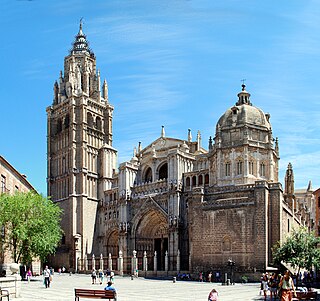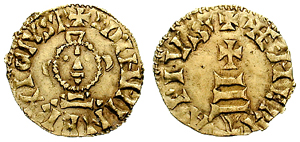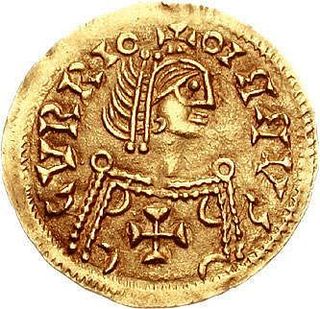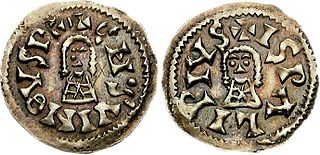Related Research Articles

Isidore of Seville was a Hispano-Roman scholar, theologian, and archbishop of Seville. He is widely regarded, in the words of 19th-century historian Montalembert, as "the last scholar of the ancient world".
Pope Eugene I was the bishop of Rome from 10 August 654 to his death. He was chosen to become Pope after the deposition and banishment of Martin I by Emperor Constans II over the dispute about Monothelitism.

Reccared I was Visigothic King of Hispania and Septimania. His reign marked a climactic shift in history, with the king's renunciation of Arianism in favour of Roman Christianity in 587.

The Mozarabic Rite, officially called the Hispanic Rite, and in the past also called the Visigothic Rite, is a liturgical rite of the Latin Church once used generally in the Iberian Peninsula (Hispania), in what is now Spain and Portugal. While the liturgy is often called 'Mozarabic' after the Christian communities that lived under Muslim rulers in Al-Andalus that preserved its use, the rite itself developed before and during the Visigothic period. After experiencing a period of decline during the Reconquista, when it was superseded by the Roman Rite in the Christian states of Iberia as part of a wider programme of liturgical standardization within the Catholic Church, efforts were taken in the 16th century to revive the rite and ensure its continued presence in the city of Toledo, where it is still celebrated today. It is also celebrated on a more widespread basis throughout Spain and, by special dispensation, in other countries, though only on special occasions.

Roderic was the Visigothic king in Hispania between 710 and 711. He is well-known as "the last king of the Goths". He is actually an extremely obscure figure about whom little can be said with certainty. He was the last Goth to rule from Toledo, but not the last Gothic king, a distinction which belongs to Ardo.
This is a historical timeline of the Iberian Peninsula during the period of the post-Imperial kingdoms.

Erwig was a king of the Visigoths in Hispania (680–687).
Julian of Toledo (642–690) was born in Toledo, Hispania. He was well educated at the cathedral school, was a monk and later abbot at Agali, a spiritual student of Saint Eugene II, and archbishop of Toledo. He was the first bishop to have primacy over the entire Iberian Peninsula—a position he has been accused of securing by being complicit in 680 in the supposed poisoning of Wamba, king of the Visigoths—and he helped centralize the Iberian Church in Toledo. His elevation to the position of primate of the Visigothic church was a source of great unhappiness among the kingdom's clergy. And his views regarding the doctrine of the Trinity proved distressing to the Vatican.

Braulio was bishop of Zaragoza and a learned cleric living in the Kingdom of the Visigoths.

Ildefonsus or Ildephonsus was a scholar and theologian who served as the metropolitan Bishop of Toledo for the last decade of his life. His Gothic name was Hildefuns. In the Ethiopian Orthodox Tewahedo Church he is known as Dexius based on the Ge'ez translation of legends about his life.
Eugenius I was Archbishop of Toledo from 636 to 646. He became successor in 636 of Justus in that metropolitan see. Like his predecessor he had been a disciple of Helladius in the monastery of Agali. He is famous as an astronomer and astronomical mathematician.

SisnandoDavides was a Mozarab nobleman and military leader of the Reconquista, born in Tentúgal, near Coimbra. He was a contemporary and acquaintance of El Cid, but his sphere of activity was in Iberia's southwest.
Maximus was the first Visigothic bishop of Zaragoza (Hispania) in 592–619. He was also a theologian and historian.
Eugenius was a 4th-century Roman emperor.

The Visigothic Kingdom, Visigothic Spain or Kingdom of the Goths occupied what is now southwestern France and the Iberian Peninsula from the 5th to the 8th centuries. One of the Germanic successor states to the Western Roman Empire, it was originally created by the settlement of the Visigoths under King Wallia in the province of Gallia Aquitania in southwest Gaul by the Roman government and then extended by conquest over all of Hispania. The Kingdom maintained independence from the Eastern Roman or Byzantine Empire, whose attempts to re-establish Roman authority in Hispania were only partially successful and short-lived.

Masona or Mausona was the Bishop of Mérida and metropolitan of the province of Lusitania from about 570 until his death. He is famous for exercising de facto rule of the city of Mérida during his tenure as bishop and for founding the first confirmed hospital in Spain.
Taius was a bishop of Zaragoza during the Visigothic period, from 651-664, succeeding his teacher Saint Braulius. His surname was Samuel (Samuhel). Taius, like Braulius and Bishop Ildefonsus, was also a pupil of Saint Isidore of Seville.

The Abbey of Santa Engracia was a monastery in Zaragoza, Aragon, Spain, established to house the relics of Saint Engratia and the many martyrs of Saragossa. The date of 392 was traditionally claimed as a foundation date, which was linked with the travels of Saint Paulinus. The church was believed to have been sited on the spot of the martyrdom of Engratia.

Chindasuinth (also spelled Chindaswinth, Chindaswind, Chindasuinto, Chindasvindo, or Khindaswinth was Visigothic King of Hispania, from 642 until his death in 653. He succeeded Tulga, from whom he took the throne in a coup. He was elected by the nobles and anointed by the bishops on April 30, 642.

Toledo is the repository of more than 2000 years of history. Successively a Roman municipium, the capital of the Visigothic Kingdom, a fortress of the Emirate of Cordoba, an outpost of the Christian Kingdom, and in the 16th century, the temporary seat of supreme power under Charles V. Its many works of art and architecture are the product of three major religions – Judaism, Christianity and Islam.
References
- ↑ Tommaso Stancati, ed.: Julian of Toledo, Prognosticum Futuri Saeculi (Mahwah, NJ: The Newman Press, 2010), p. 478, note 91.
- ↑ Julianus of Toledo. The Story of Wamba, CUA Press, 2005 ISBN 9780813214122
- ↑ Von Hefele, Karl Joseph. A History of the Councils of the Church, T. & T. Clark, 1895
- 1 2 3 McNeal, Mark. "Eugenius II (the Younger)." The Catholic Encyclopedia. Vol. 5. New York: Robert Appleton Company, 1909. 2 Apr. 2015
- ↑ Constable, Olivia Remie and Zurro, Damian. Medieval Iberia, University of Pennsylvania Press, 2012 ISBN 9780812221688
- ↑ Ungvary, David (2018). "The voice of the dead king Chindasuith: poetry, politics, and the discourse of penance in Visigothic Spain". Early Medieval Europe. 26 (3): 330.